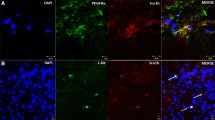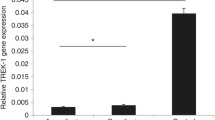Abstract
Purpose
Voltage-gated potassium ion channels have long been implicated in gastrointestinal motility. Recent studies have highlighted the role of voltage-gated channel subfamily G member 3 (KCNG3) and 4 (KCNG4) genes in the electrical functioning of interstitial cells of Cajal and PDGFRα+ cells of the mouse colon. We designed this study to investigate KCNG3 and KCNG4 expression in the normal human colon and in Hirschsprung’s disease (HSCR).
Methods
HSCR tissue specimens (n = 6) were collected at the time of pull-through surgery, while control samples were obtained at the time of colostomy closure in patients with imperforate anus (n = 6). qRT-PCR analysis was undertaken to quantify KCNG3 and KCNG4 gene expression, and immunolabelling of KCNG3 and KCNG4 proteins was visualized using confocal microscopy.
Results
qRT-PCR analysis revealed significant downregulation of the KCNG3 and KCNG4 genes in both aganglionic and ganglionic HSCR specimens compared to controls (p < 0.05). Confocal microscopy revealed KCNG3 and KCNG4 expression within neurons, ICC and PDGFRα+ cells of the myenteric plexus and smooth muscle layers, with a reduction in both proteins in aganglionic and ganglionic HSCR colon compared to controls.
Conclusion
KCNG3 and KCNG4 gene expression is significantly downregulated in HSCR colon, suggesting a role for these genes in colonic motility. KCNG3 and KCNG4 downregulation within ganglionic specimens highlights the physiologically abnormal nature of this segment in HSCR patients.



Similar content being viewed by others
References
Heinemann S, Rettig J, Scott V, Parcej DN, Lorra C, Dolly J, Pongs O (1994) The inactivation behaviour of voltage-gated K-channels may be determined by association of alpha- and beta-subunits. J Physiol Paris 88(3):173–180
Regnier G, Bocksteins E, Marei WF, Pintelon I, Timmermans JP, Leroy J, Snyders DJ (2017) Targeted deletion of the Kv6.4 subunit causes male sterility due to disturbed spermiogenesis. Reprod Fertil Dev 29(8):1567–1575. https://doi.org/10.1071/RD16075
Bocksteins E, Snyders DJ, Holmgren M (2017) Independent movement of the voltage sensors in KV2.1/KV6.4 heterotetramers. Sci Rep 7:41646. https://doi.org/10.1038/srep41646
Lee MY, Ha SE, Park C, Park PJ, Fuchs R, Wei L, Jorgensen BG, Redelman D, Ward SM, Sanders KM, Ro S (2017) Transcriptome of interstitial cells of Cajal reveals unique and selective gene signatures. PLoS One 12(4):e0176031. https://doi.org/10.1371/journal.pone.0176031
Ha SE, Lee MY, Kurahashi M, Wei L, Jorgensen BG, Park C, Park PJ, Redelman D, Sasse KC, Becker LS, Sanders KM, Ro S (2017) Transcriptome analysis of PDGFRalpha + cells identifies T-type Ca2 + channel CACNA1G as a new pathological marker for PDGFRalpha + cell hyperplasia. PLoS One 12(8):e0182265. https://doi.org/10.1371/journal.pone.0182265
Curro D (2014) K(+) channels as potential targets for the treatment of gastrointestinal motor disorders. Eur J Pharmacol 733:97–101. https://doi.org/10.1016/j.ejphar.2014.03.049
Ward SM, Sanders KM (2006) Involvement of intramuscular interstitial cells of Cajal in neuroeffector transmission in the gastrointestinal tract. J Physiol 576(Pt 3):675–678
Rolle U, Piotrowska AP, Nemeth L, Puri P (2002) Altered distribution of interstitial cells of Cajal in Hirschsprung disease. Arch Pathol Lab Med 126 (8):928–933. https://doi.org/10.1043/0003-9985(2002)126%3C0928:ADOICO%3E2.0.CO;2
Piotrowska A, Solari V, Puri P (2003) Distribution of interstitial cells of Cajal in the internal anal sphincter of patients with internal anal sphincter achalasia and Hirschsprung’s disease. Arch Pathol Lab Med 127(9):1192–1195
Nemeth L, Puri P (2001) Three-dimensional morphology of c-Kit-positive cellular network and nitrergic innervation in the human gut. Arch Pathol Lab Med 125(7):899–904
Kurahashi M, Nakano Y, Hennig GW, Ward SM, Sanders KM (2012) Platelet-derived growth factor receptor alpha-positive cells in the tunica muscularis of human colon. J Cell Mol Med 16(7):1397–1404. https://doi.org/10.1111/j.1582-4934.2011.01510.x
O’Donnell A, Coyle D, Puri P (2016) Deficiency of platelet-derived growth factor receptor-α-positive cells in Hirschsprung’s disease colon. World J Gastroenterol 22(12):3335–3340
Author information
Authors and Affiliations
Corresponding author
Rights and permissions
About this article
Cite this article
O’Donnell, A.M., Nakamura, H., Tomuschat, C. et al. Altered expression of KCNG3 and KCNG4 in Hirschsprung’s disease. Pediatr Surg Int 35, 193–197 (2019). https://doi.org/10.1007/s00383-018-4394-2
Accepted:
Published:
Issue Date:
DOI: https://doi.org/10.1007/s00383-018-4394-2




